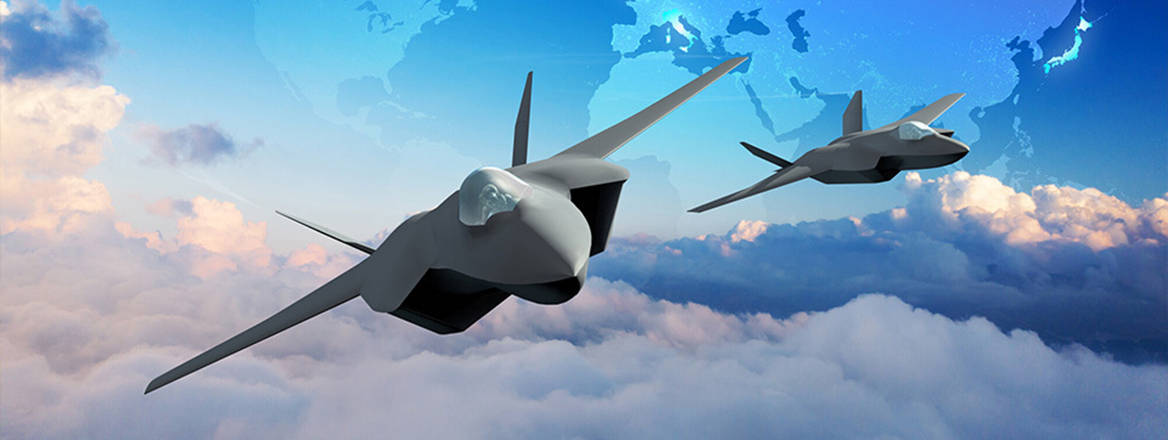The Global Combat Air Programme: The First Round of Hard Choices?
As cooperation between the UK, Italy and Japan on a next-generation fighter aircraft takes shape, a series of challenges lie ahead.
When the UK, Italy and Japan agreed in December 2022 to collaborate on joint development of a next-generation fighter aircraft, justified excitement at the strategic significance was attended by equally reasonable apprehension; seeking to harness the latest technology on an unusually short timescale through a newly constructed collaborative partnership with a 2035 initial operating date was nothing if not ambitious. Since then, there have been few announcements on progress beyond a commitment by BAE Systems to build a demonstrator by 2027. Initial discussions are believed to be concentrating on the government and commercial delivery organisations that need to be set up, with a deadline of no more than two years from the original announcement of the Global Combat Air Programme (GCAP) for first contracts to be awarded. With London’s DSEI conference from 12–September bringing together many of the partners involved in the project, this offers a moment to take stock of progress and to assess the coming challenges: not only the timeframe, but also organisational structure, extending the range of partners, export policy alignment, and information security.
When it comes to assessing the feasibility of this programme, the Eurofighter experience is looked to as a benchmark for comparison. The UK and Italy have previously collaborated on both the Tornado and Eurofighter/Typhoon programmes, but Japan’s experience of defence equipment collaboration has been limited to cooperation with the US on the SM 3 Block IIA missile. While the Eurofighter programme had many successes, and all partners believe in the capability of the final aircraft, there is also a recognition that its entangled processes for determining workshare, which left ultimate decision-making to the politicians, would be unsustainable for meeting GCAP’s 2035 initial operating date.
The industry partners from all three countries are believed to have divided into teams focusing on the airframe, the engines and the electronics. BAE Systems, Mitsubishi Heavy Industries and Leonardo Aircraft in Italy will collaborate on the airframe; Rolls-Royce, IHI and Avio Aero will work on the engines; and Leonardo UK, Mitsubishi Electric (MELCO), Leonardo Italy and Elettronica will collaborate on the electronics under the ISANKE and ICS programme that was announced at DSEI Japan in March 2023. MBDA, representing the UK and Italy, will share weapons development and integration with MELCO. For a commercial structure of adequate simplicity to be delivered, all these teams probably need to report to a single entity.
Seeking to harness the latest technology through a newly constructed collaborative partnership with a 2035 initial operating date is nothing if not ambitious
Meanwhile, the governments will need to establish a joint programme office capable of tasking the commercial entity to deliver the programme. The experience of the Eurofighter programme suggests that collocation of the commercial and government entities will be key; despite the efficiencies of modern virtual communications, there is no substitute for close proximity for senior officials, managers and designers struggling to cope with a challenging timetable. There is as yet no information on where the various offices will be, but there will no doubt be a strong desire from all three countries to emulate the prestigious role that Munich played in Eurofighter. Setting up a joint programme office will require a trilateral treaty, but there is no sign yet of progress on that front. Consequently, the location decided upon for the commercial entity may end up driving the decision for the whole project.
There has been recent speculation that further partners will join the GCAP consortium, with Saudi Arabia identified as a potential key partner. Given the intricacies of creating the appropriate commercial and government entities, together with the tight timetable, it is highly unlikely that there is room for a fourth partner at the top level, not least because other countries such as Sweden may also seek to re-engage, and each potential new partner may have much to offer in terms of technology, finance or confirmed market.
Export potential may be key to GCAP’s financial viability. Previous RUSI commentaries pointed out the huge cost of this programme and warned that declared budgets are likely to be well short of what is needed, whatever may already have been brought to the programme by investment in the UK through Tempest and in Japan through the ATDX demonstrator in 2016. The Eurofighter programme showed how arguments over export markets (particularly German opposition to exports to Saudi Arabia) can impact the rate of development and delivery to an extent that would pose a risk to this programme. Japan is reviewing its approach to defence technology and equipment transfer, which is currently more restrictive than that of the UK or Italy, although there is increasing acceptance of transfers to countries that have appropriate government agreements with Japan.
Given the intricacies of creating the appropriate joint entities, together with the tight timetable, it is highly unlikely that there is room for a fourth partner at the top level
The question of aligning export policies is an early reminder of the challenges that will be involved in harmonising foreign as well as industrial policy processes among the trinational partnership. The UK and Italy benefit from common NATO membership and have substantial experience of collaboration, which will help. Japan’s defence industrial environment has developed in relative isolation from the global defence market, and approaches to issues such as security clearances, creating a suitably secure and empowered shared working environment, and management of intellectual property developed outside the programme will give the new joint entities much to consider. Japan may be tempted to create a bespoke environment for GCAP alone to avoid the time needed for something more sustainable, but this could in turn cause problems as it would exclude parallel programmes that may yet be needed to broaden the collaborative foundations.
The presence of the GCAP teams at DSEI in London will raise expectations of announcements on progress. Among the elements listed above, the main ones to look out for will be confirmation of demonstrator programmes, creation of a joint entity, and the terms of engagement with new partners.
The views expressed in this Commentary are the authors’, and do not represent those of RUSI or any other institution.
Have an idea for a Commentary you’d like to write for us? Send a short pitch to commentaries@rusi.org and we’ll get back to you if it fits into our research interests. Full guidelines for contributors can be found here.
WRITTEN BY
Simon Chelton
RUSI Associate Fellow, International Security
Dr Philip Shetler-Jones
Senior Research Fellow, Indo-Pacific Security
International Security
- Jim McLeanMedia Relations Manager+44 (0)7917 373 069JimMc@rusi.org



